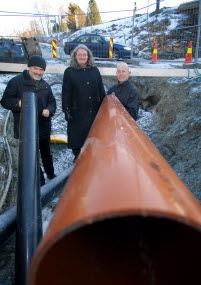
|
They occupy an office block behind Lerkendal Stadium in Trondheim and are experts in hidden treasure: the water supply network, one of society's most valuable buried assets.
Like their neighbours, Rosenborg Football Club, the water and sewage scientists at SINTEF Building Research have been given the opportunity to show off their skills abroad. In the course of a year they have won two contracts worth a total of NOK 2 million in the USA; the first in Las Vegas and now, in Hillsborough County, Florida.
The export product is an ingenious planning tool for renewal of the water supply network: simulation software that makes sure that the right pipelines are replaced at the right time; i.e. before they start to leak.
This is a tool that the SINTEF scientists can see a need for all over the world, and which they have already used in a number of Norwegian cities.
If all goes as the scientists hope, these contracts on both sides of the Atlantic could be the start of a development that will lead to a future SINTEF spin-off with the potential for a high rate of growth.
Saving both money and water
The “product” that the Trondheim research group is bringing out into the big wide world is an analytical tool called “Computer-Aided REhabilitation of Water networks (CARE-W), a software package that SINTEF Building Research and NTNU have helped to develop under the auspices of the EU.
The software assesses the condition and performance of the water supply grid in a new, systematic way, giving water engineers a tool that they have lacked until now, according to SINTEF's Leif Sigurd Hafskjold, who is leading the projects in the US.
“The system provides a basis for making decisions that ensure that water pipes are not renewed too late, but not too early either. This can save local authorities and other supply grid owners large amounts of unnecessary spending as well as saving water, which is a scarce resource in many parts of the world”, explains Hafskjold.
His list of wishes is headed by project funding that would enable the group to develop the software into a commercial product.
“If we do a really good job in this phase, I can envisage a spin-off company based in Trondheim that would grow fairly large in the course of a few years and become a world leader in advanced planning models for water and sewage networks”, says the SINTEF scientist.
Reactions usually too late
The CARE-W project is based on observations made by Norwegian and other scientists in their own countries, and which are described in the following terms by SINTEF's Leif Sigurd Hafskjold: “The usual situation is that owners of water supply networks react only when reports of faults begin to come in. But by that time, the failures may well have been been frequent and serious enough to have caused damage and financial loss. And it is not unusual for a decision to dig up a pipeline to be made immediately after another department has been excavating in the same area and has just filled in its trenches.
The SINTEF scientists' optimism regarding the market potential for CARE-W is due to the fact that the “patch up the damage” philosophy is currently meeting a counter-current of opinion in many parts of the world: a growing interest in managing collective investments correctly, including the values laid down in the water and sewage network. It is not so strange that such a wave of interest has arrived; this sector is not handling small change.
“If Norway were to replace the whole of its local water and sewage networks all at once, it would cost NOK 400 billion, which is half of the national budget,” says Hafskjold.
Help to “see” beneath the surface
CARE-W is tailor-made for this wave of awareness.The software helps local authorities that wish to improve their water supply management and rehabilitation programmes. According to Hafskjold, analyses are alpha and omega for the people who watch over our subterranean infrastructure.
“People who assess the maintenance requirements of buildings can measure humidity and count cracks. But this is a much more expensive process where buried water and sewage pipelines are concerned.
Good management in the water supply and sewage sector is now in sharp focus on both sides of the Atlantic. In Norway, SINTEF Building Research has used the CARE-W software package to help around 20 local authorities to estimate their maintenance requirements.
Interest in asset management is also rapidly growing in the USA. This has led to SINTEF Building Research being invited to join projects with its CARE-W software in two cities of a million inhabitants over there.
The first order from the USA came to SINTEF Building Research just over a year ago from the desert gambling city of Las Vegas, a rapidly growing city with limited access to water, where there is a particularly strong desire to avoid leaky water pipes. As a sub-contractor to New York's Polytechnic University, Hafskjold and his colleagues have been helping the Las Vegas Valley Water District to adopt the CARE-W package. The original contract has been extended, and now includes two additional partners from the CARE-W consortium. This is an example that the partners involved in the CARE-W project are still cooperating and further developing the ideas.
The second order recently came in from Hillsborough County, which surrounds Tampa, one of the largest cities in the State of Florida. This is a one-year project worth 1 million NOK The project involves the SINTEF scientists using the CARE-W package on its own, as sub-contractors to the UK Halcrow Group consulting company. Now they have also been contacted by the City of Tampa, which wishes to know more about the capabilities of the software.
Only the future will tell whether Leif Sigurd Hafskjold and his colleagues will be transatlantic commuters in the future...
by Svein Tønseth
